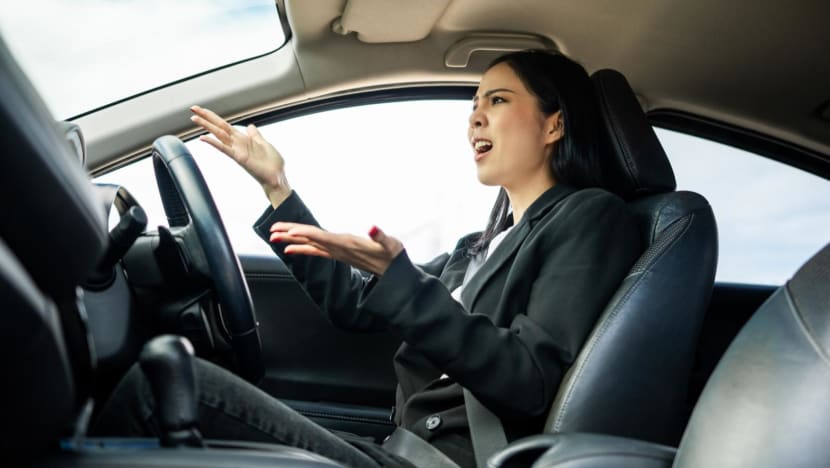Are drivers in Singapore inconsiderate? Yes, say observers
Observers tell CNA’s Deep Dive podcast that bad driving habits stem from a culture of “always rushing” that many Singaporeans follow – and not just on the roads.

Some road users’ biggest pet peeves include drivers recklessly cutting lanes, inattentive cruising, and a lack of basic courtesy. (Photo: iStock)

This audio is generated by an AI tool.
SINGAPORE: The recent spate of high-profile traffic accidents in Singapore has sparked conversations about the local driving etiquette and culture.
Some road users’ biggest pet peeves include drivers recklessly cutting lanes and queues, inattentive cruising, and a lack of basic courtesy – not giving way, not conveying gratitude when others give way, and not apologising for inconsiderate actions.
The Singapore Police Force said in its annual report on road traffic situations there was a significant increase in the number of accidents last year where drivers failed to keep a proper lookout, failed to control their vehicles properly, and changed lanes without due care.
Observers said these bad driving habits stem from a culture of “always rushing” that many Singaporeans follow – and not just on the roads.
“Even in malls and (supermarkets), people with trolleys will jump your queue or cut your lane and it’s the same thing on the roads,” said Singapore Road Safety Council chairman Bernard Tay.
“The culture in general in our society is always rushing, always competing… this mindset and behavioural culture need to be changed,” he told CNA’s Deep Dive podcast.
WHY DO DRIVERS SPEED?
One of the top culprits of traffic violations are speeding drivers, with 115,705 cases last year. Speeding-related fatalities soared 83 per cent to 33, up from 18 in 2022.
Observers said a top reason why drivers speed on Singapore’s roads is due to poor time management.
“Our roads are filled with people who are always in a rush. We have a very impatient culture, whether it is because of bad planning or bad time management. Then they blame it on the traffic and get angry,” said Mr Julian Kho, editor of online platform SGCarmart.
He added that while he, too, does not plan his routes regularly, he allows a 15-minute buffer each trip to ensure he drives his sedan safely.
“I leave the house earlier. I don't want to rush. I've got my family with me, and I don’t want to take risks,” he said.
Another reason for speeding could be peer pressure from other drivers, said Mr Tay.
“When somebody's driving fast on the road, others follow to keep up. Even if you are going at the speed limit, people look at you and bypass you… and you go faster,” he said.
Observers also cautioned those making the switch to electric vehicles (EVs) to be more aware of their speed, as the acceleration is much faster compared with that of conventional petrol-fuelled cars.
“A regular ICE (internal combustion engine) car can go from zero to 100kmh in about nine seconds. It's half when it comes to EVs,” said Mr Kho, who was also a guest on the podcast. “If a nine-second car can cause accidents and kill people, can you imagine the disaster that an EV can cause?”
Those who violate speed limits may face demerit points, a fine and a jail term.
INCREASE IN FATAL ACCIDENTS
Last year, the number of traffic accidents resulting in fatalities increased to 131 cases, a 26 per cent increase from 104 cases in 2022.
The number of accidents resulting in injuries also increased, up slightly by 2.4 per cent on-year to 6,944, an average of almost 20 cases each day.
Among dangerous driving manoeuvres is reckless cutting into lanes.
“When someone cuts into a lane, especially in front of a heavy vehicle, the driver is risking his own life, because heavy vehicles take some time to slow down. A lot of people don’t realise the seriousness of cutting lanes recklessly,” said Mr Tay.
He added that drivers who routinely drive the same route can zone out and fail to be aware of their speed or surroundings.
Hence, traffic calming devices such as speed bumps need to be in place near school areas and silver zones – for elderly pedestrians – to remind drivers to slow down and drive carefully.
Two weeks ago, Mr Tay’s council formed a task force to put up more visual cues for drivers, following the string of prolific traffic incidents in the past few months.
The task force will hang banners on overhead bridges with safety reminders such as not speeding, as well as erect standees at accident prone areas to remind pedestrians not to jaywalk.
BAD DRIVING CULTURE?
Observers said Singapore’s traffic laws and penalties are comparable to other countries’, pointing instead to the mindset that needs to be improved.
“Driving brings out the worst in people,” said Mr Kho. “I know of people who are really nice when they're not driving, but when they're behind the wheel, they're completely different.”
Mr Tay said: “Enforcement can be done up to a point, but if people continue to drive without looking out for themselves or other road users, then the roads will still be unsafe. We need to educate and reshape the mindset.”
He suggested that on top of existing penalties, offenders should be sent to a refresher course on traffic rules, road safety and proper driving etiquette.
As part of his role on the council, he has travelled to Japan and South Korea to learn about their efforts to make roads safer.
While building more traffic measures such as humps, speed-regulating strips, traffic lights and designating zones for schools and the elderly can be resource-intensive, Mr Tay said they are necessary to mitigate accident risks and rates.
“Every other developed country is doing this – creating the infrastructure to force drivers to be careful. We hope that by (forcing behaviour), this will eventually be part and parcel of the driving culture,” he explained.
Mr Kho said: “If we cannot change the culture, if we cannot educate drivers, then perhaps forcing them to change their behaviour on the road will become a habit eventually. (Maybe) it will really drill into them that we should slow down whenever we need to.”
Both men concluded by saying road safety is everybody’s responsibility.
“We need to pay attention a little bit more. We all share the roads. Sometimes, you need to put other people first,” said Mr Tay. “Think about it – how much time are you going to lose (by being considerate), really? It’s always better late than never.”
Mr Kho said: “There’s a lot of responsibility when someone gets behind the wheel. You can hurt yourself and others around you. Hopefully with more enforcement, or at least more awareness and education, our driving culture can improve.”
















